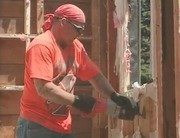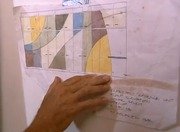Aluminum Replacement Window Installation
Carpenter Bob Ryley and Bob George (from New England Window) install a bronze aluminum replacement window in an arched-top masonry wall.
Clip Summary
Carpenter Bob Ryley and Bob George (from New England Window) install a bronze aluminum replacement window in an arched-top masonry wall.Bob Vila: All right. Let's hook up with two more Bob's. Bob George from New England Windows, and Bob Riley. How are you? Bob George: Good, good. Bob V: This is a real different breed from the usual residential window. What is it that makes this a different type of window? Bob G: The windows are rated as per how many storied buildings they are. Bob V: So it's the sturdiness of the window? Bob G: The sturdiness of the window, right. Bob V: The strength of the aluminum extrusion, the thickness of the glass? Bob G: Correct. The thickness of the glass, the thermal panes. Some of them are thicker than others. Bob V: Aluminum windows, I always worry about the cold infiltrating. How do you deal with that here? Bob Ryley: What they have here is a thermal break in the frame itself that's going to prevent any condensation from coming back into the unit. Bob V: There's an actual vinyl separation between the outside aluminum and the inside part of the aluminum? Bob G: Exactly. Bob V: And you don't get conductivity. It's a heavy window. Is it an expensive item? Bob G: Approximately $400 a window, installed. Bob V: That, of course, is specific‑priced to these openings? Bob G: Correct. Bob V: How big is it? Bob G: It's about 49 and a half by 83. Bob V: Installing it is not an easy job, especially up here on the sixth floor. How do you go about it? Bob G: The weight of the window gets a little heavy on this side so what we usually do is we remove the sashes before we install the window. Bob V: Oh, so the sash comes out? Bob G: Correct. Bob V: Does that also mean that when it's installed and people are living here, you can tilt it in to clean it? Bob G: That's correct, Bob. Bob V: Super. How do they come out? Do you just...? [window clanking sound] Bob G: Pops right out like that. Bob V: Tilt that on an angle and it comes out? OK. Bob G: Move it out of the way. Bob V: Each one of the openings in this old building is actually arched at the top, right? Bob G: Correct. Bob V: So you've got to do a little bit of customizing? Bob G: Yeah. What we have to do is we have to get a template here which is pre‑made that we have done earlier this morning, and what we do is we trace the top of the window to conform to the brick on the outside. [power tool whirs] Bob V: Then you've got power snaps that make the job go really quickly? Bob G: Right, and we use these power sheers to cut them out. Saves a lot of time and a lot of aggravation. Enhancements. [power tool whirs] Bob G: We're going to put a bowline on this, a simple knot. The rabbit comes through the hole, around the tree, back through the hole, and that's it. Bob V: And we've got it tied to the column behind you, Bob, so you're not actually going over the side just yet. Bob G: No, I hope not. Bob V: So now we take the plywood out, right? Bob G: Yes. What I'm going to do is unscrew the plywood. [power tool whirs] Bob G: Got it. Bob V: There we go. Bob G: All right. There you go. [board slams] Bob G: I got it. Bob V: The windows are solely granite, and we're actually going to use a strip of bitchathane, this product that's also used as a moisture barrier in roofing. Why don't you put it down there? We're going to put that right on top of the granite so that when the aluminum base of the window rests on it, you won't have any cold coming through from the granite through the aluminum. Now we'll put in the frame, you got it? Bob G: Yep. Bob V: You got to get up there, Bob? Bob G: Yep. Bob R: It's got to go out sideways and then back in. Bob G: OK. You got it. Bob R: Put them on, one side at a time. Bob G: There we go. Helper: Good. Which side do you want? Bob G: This side here. Bob R: Like every window installation, you're still relying on shim shingles to get things tight before you drive the screws into the sides. Bob G: Thank you. [power tool whirs] Bob R: What kind of fasteners are we using? Bob G: These are a masonry anchor that threads directly into the mortar. Bob R: Exactly. They're the tempered steel masonry screws. [power tool whirs] Bob G: There you go. Bob R: Now we have to put a lot of caulking in but this is actually a polyurethane polymer that you load into this thing. It's like a sausage, isn't it? Bob G: Yes, it is. Bob R: Then you cut the tip off and... Bob G: You snip a tip off of that and then we screw on the cone that we have cut to fit the size of the caulk joint. Bob R: Right. That's the key element because the space between the aluminum and the masonry is about three‑eights of an inch, and you want this nice fat bead out there that's going to keep the elements out. [pause] Bob G: You ready? Bob R: Yep. Bob G: Grab the bottom. Helper: Got it. Bob G: All right. Back. Down. Helper: Good? [pause] Bob V: All right, and then a little contortion and you get the bottom sash on its tracks. Helper: OK. Bob G: All set. Bob V: Flip it up and down and we're done! Thank you, fellas. Oh, feeling warm right here already.





